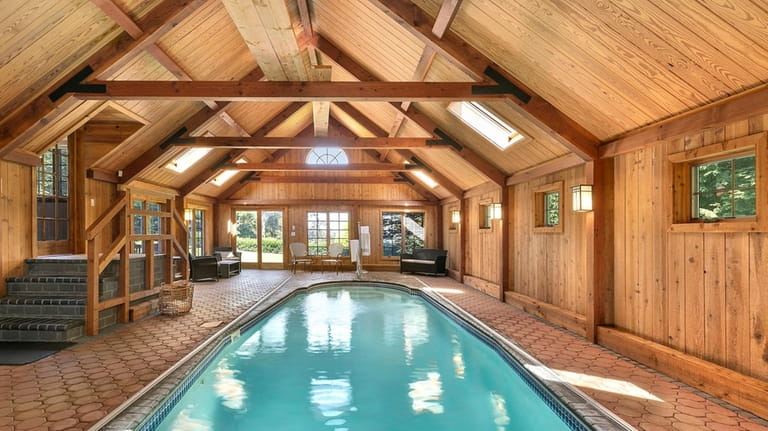Houses with indoor pools on Long Island offer rare luxury
Construction business partners John Cunha and Nelson Fernandes gut-renovated their summer home in Ocean Beach, after buying the property in 2018 — "We took it down to the two-by-fours and redid the whole thing," Cunha said.
That included turning the two-car garage into an indoor swimming pool.
"There’s a lot of stuff you have to do," said Cunha, 50, of Blue Point. "You need a dehumidifying system. If not, you’re going to create mold inside your house. And the construction of it is a little bit more complex, building material-wise."
Cunha and Fernandes learned as they went. "Once you have it, it’s a good thing," said Fernandes, 49, of Setauket. "But there is a lot of extra work involved to maintain an indoor pool."
There are local experts familiar with what it takes, from real estate agents who sell properties like this, to builders and engineers for whom this uncommon feature is a specialty.
For Long Islanders enjoying this luxury, the weather and changing seasons aren't factors: They can take a dip year-round, and cleaning is a breeze when your pool is under a roof. When it comes time to list the property, an indoor pool is a selling point, real estate agents say.
But it comes with a big price tag. Installing one can cost hundreds of thousands of dollars, and high carrying costs — including increased electricity bills — come along with it.
Swimming under your own roof is a treat for some Long Islanders, though — especially those with an affinity for water.
"What a luxury to have: To go inside of a house and be able to walk out into a pool. It’s fantastic," said Steve Kenny, founder of SRK Pool Services in Wainscott. He’s also an aquatic designer, builder and technician who has worked in the industry more than 30 years.
Swimming pools are uncommon to find inside Long Island homes, Kenny and other experts say.
"We’ve installed maybe under a dozen [indoor swimming pools] over the past 10 years," he continued. "It’s not commonplace, but I am starting to see an uptick in it, especially in the city."
Indoor pools as a selling point for homes on market

This Riverhead home has an indoor pool. Credit: Elisa Dragotto
Kate DiGregorio is a real estate agent for The Corcoran Group, based in its Cutchogue office. She is co-listing a 3,800-square-foot property in Riverhead with three bedrooms, four bathrooms and a 10-by-30-foot heated saltwater pool, surrounded by wood paneling and skylights. The house is on the market for $2.29 million.
"It’s a beautiful room," said DiGregorio. "It overlooks the Sound, and the owners use it pretty much year-round. It’s a big selling point for somebody who’s looking for that, and we’ve had a lot of activity on it."
As an agent working on Long Island's North Shore, DiGregorio said this amenity is unusual for the area, adding that prospective buyers have been "pleasantly surprised" by it. The room has both an interior and exterior entrance, and a full bathroom nearby.
Coming into the house, a right turn leads to the pool, while a left brings you to the main living space, DiGregorio explained.
"It has its own separate wing of the house," she said. "But it doesn't feel like it’s an odd location, because it blends so nicely with the floor plan."
Bonnie Glenn, of Daniel Gale Sotheby’s International Realty, recently had a listing in Nissequogue featuring two pools: One inside, and another in the backyard. Having swimming instructors come to the house to give lessons could be a perk for some buyers, she said.
"It’s not exposed to outdoor elements like snow, rain, leaves and debris," Glenn added. "So they kept it so clean, and it’s easy to maintain."
But overall, reactions to the indoor pool varied while she was showing the house.
"If someone had a child that was a competitive swimmer or it was someone who loved to swim every day for exercise, it was a wonderful thing," she said. "And on the opposite end, people with young kids could be afraid they’d get in there, and it could be dangerous."
Through a tunnel sits this indoor pool in a $6.65 million Garden City home. Credit: Newsday/Alejandra Villa Loarca
Gina Padro, an associate broker at Keller Williams Realty, is listing a house in Garden City for $6.65 million. It contains a separate structure that can be accessed from the main house by tunnel, with an underground heated pool. It's 14 by 24 feet, 8 feet deep and filled with saltwater.
At the Garden City home, a mechanical vinyl cover can shield the pool within seconds. It just takes the flip of a switch, located on an adjacent wall. There is also a lock on the door for the room containing the pool.
Ensuring a pool has safety features is essential, especially for a family with young kids, said Glenn. Her listing had a gate to the pool that locked, and an alarm system.
Overall, clients are more intrigued by the feature than anything else, Padro said. And in her 28-year career, this was her first listing with an indoor pool — and her first time even seeing such a feature inside a house.
"I think the biggest advantage to having something like this is you get use out of it all year long," Padro said. "It's not your typical just spring, summer, early fall pool."
One thing Glenn noticed whenever she was at the house: The lack of that infamous pool smell.
"It’s amazing how many times you think it’ll have a real chlorine smell, and it doesn’t," she said.
How much work goes into installing, maintaining indoor pools?
Cunha and Fernandes decided to raise their house and transform their garage into an indoor pool. They got a permit and the construction complied with building requirements because the exterior structure itself remained the same, Fernandes said. This also achieved their goal of offering a pool on site for guests to enjoy.
The partners now rent the house out to families during the warm weather months, through Thanksgiving. It contains four bedrooms and 3½ bathrooms, and the pool is about 16 by 12 feet, Cunha said. The systems cost $100,000, and the pool $75,000, Fernandes said.
The pool room includes towel storage, a ceiling fan, decorative oars on the wall and a seating area on the deck.
"What’s good about it is, if there’s bad weather or you have kids and the ocean is too rough, you can still hang out in the pool and still have something to do," said Fernandes.
He and his own family get some use out of it during the year, too.
"We’ve gone in the pool in October," he said. "We just close the doors and keep the heat in."
Although cleaning an indoor pool is easy (save for some sneaky sand that comes in after beach days), other factors, such as the costs and making sure the air is being circulated properly, are challenging.
"You have a pool running 12 months out of the year," he said. "That electric bill is higher in summer when the pool is running all the time — now multiply that by 12."
But renting out the house has helped with carrying costs, Cunha said. His advice to anyone undertaking a project like this: Test the waters.
"When we did this, I didn't realize how much work you had to do," he said. "It is overwhelming. It’s not like you can hit a switch and everything’s good. There’s a lot involved in it, and you really have to study and research the products that you’re using to build it."
How much can indoor pools cost?
"When you start dealing with indoor pools, you have to make sure the air quality is perfect and not making moisture in the room," Kenny said. "I think that’s where a lot of indoor pools go wrong."
Kenny is working on an indoor pool in Manhattan with an advanced oxidation system to treat and sanitize the water. If you have the budget for it, he recommends opting for one. The system delivers a "trace amount of chlorine" to the water, he said — or 0.6 parts per million.
"You can’t even detect it," he said. "When you walk into the house, you don’t even realize there’s a pool in it." He compared this experience to going to an indoor pool at a public facility. A commercial pool would typically have a chlorine level between 3 and 5 parts per million, he said.
"There’s a nasty smell — your eyes itch, your skin burns and that’s because the water is not being maintained in the correct fashion. It’s important to use more modern technology to help us maintain the water perfectly."
David J. Peterson is a professional engineer, educator and president and CEO of Watershape Consulting Inc., based in California. He’s licensed in 40 states and works on projects all over the world, including on Long Island, alongside Kenny and his team.
When installing an indoor pool, he said it’s essential to consult an architect, a pool engineer and HVAC engineer as the first steps. You should also look into your town or village permit requirements, but for some — the Town of Smithtown, for example — there is no difference in requirements for permits to be filed for an indoor (versus an outdoor) swimming pool.
"It starts with getting the right team on board to make sure all the right things are covered that need to happen," Peterson said.
For starters, a pool should have a safety cover installed for when it’s not in use, which will also prevent evaporation. "That’s the biggest thing," Peterson said.
There are a few options: A vinyl cover to pull across the top, a floating cover that deploys from the floor or wall of the pool or a movable floor that "lowers down into the pool like an elevator," Peterson said.
"That one is the best insulator out of all of them," he added. "When it’s down, you don’t even know there’s a cover there. You just see a normal pool floor."
A vinyl cover could cost somewhere between $10,000 and $15,000, while a floating cover could run from $50,000 to $60,000, Kenny said.
Sealing the room with a vapor barrier (heavy duty plastic sheets stapled to the studs on insulated walls) is vital to preventing mold issues or rot in the structure. Plus, you’ll need a dehumidifying system.
The pool itself and the systems needed for it to run effectively could typically cost between $200,000 and $250,000, Kenny said. The systems alone run from $80,000 to $125,000, he added.
And that doesn’t include the building structure that would surround the indoor pool, plus features such as lighting and radiant heat flooring in the pool deck, which Kenny recommends to his clients.
"It’s all the legwork that goes into it beforehand that dictates whether the client is going to struggle or not," Kenny said. "All of these nuances: Understanding oxidation, sanitation, dehumidification, the surface cover. All of these particulars play a role in it, and if you don't have it engineered correctly, then you’re going to struggle."
But Peterson sees real benefits for those with this kind of access to a pool.
"I think it all comes down to two words: Water and wellness," he said. "We all have a connection with water. And it’s a great way to exercise, without impact. As our bodies are getting older, everyone’s looking for ways to extend their life, and no form of exercise is better than swimming. And what we get is the ability to enjoy water and wellness 365 days a year."

